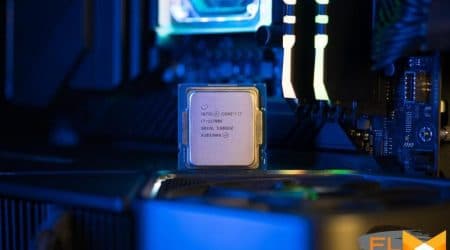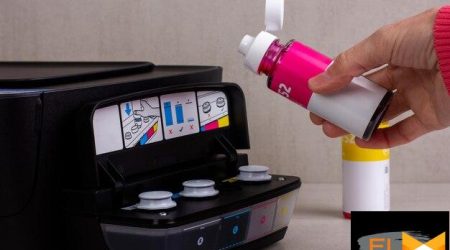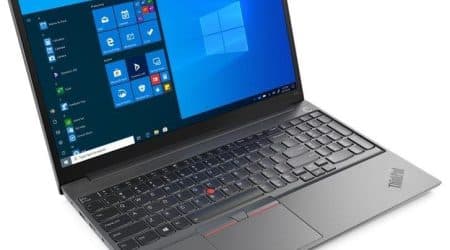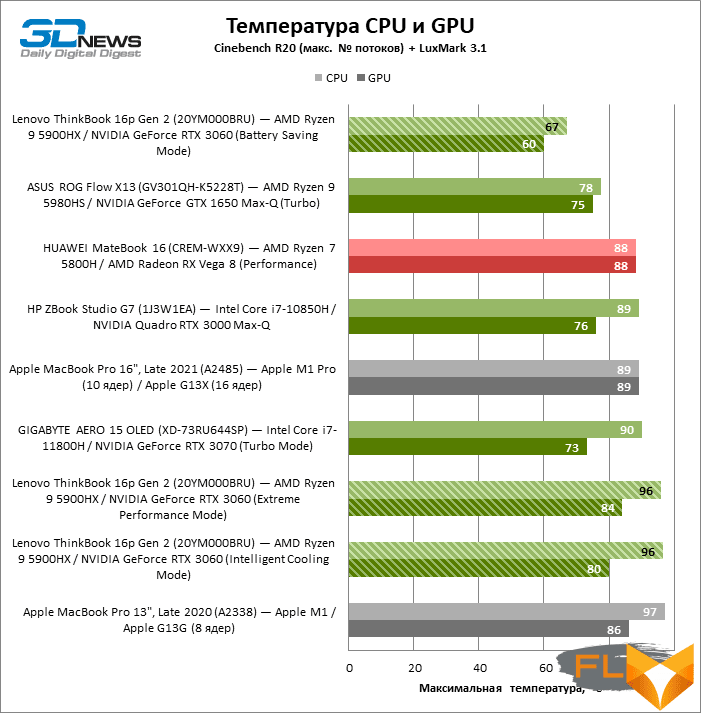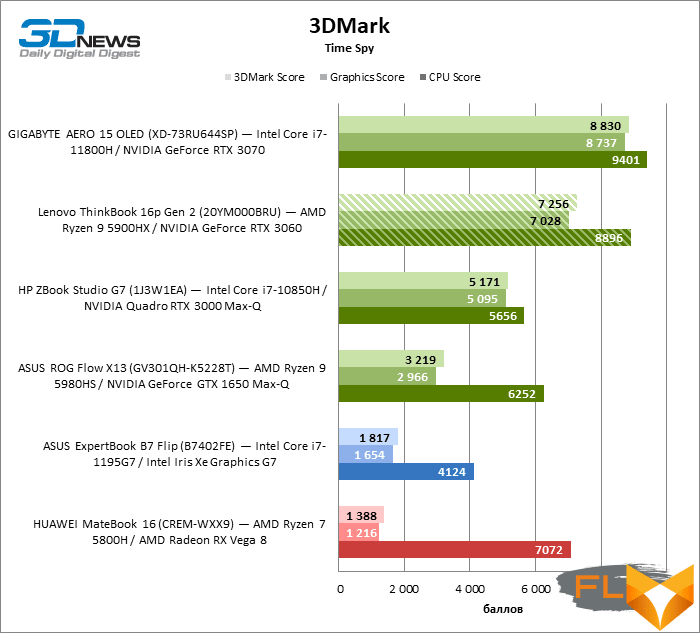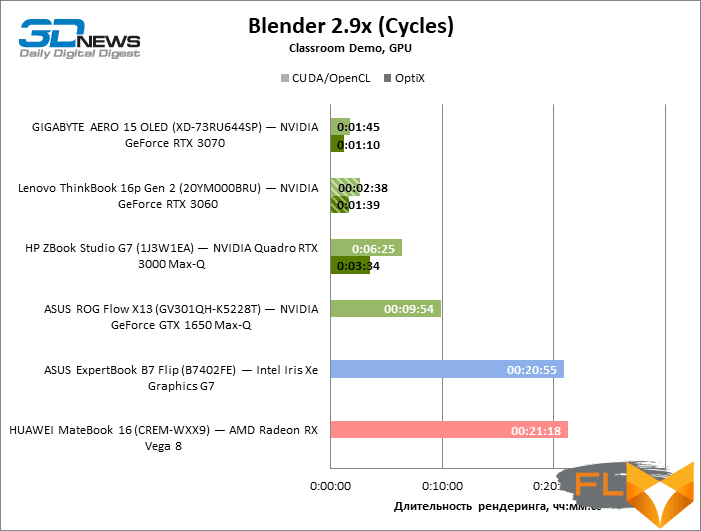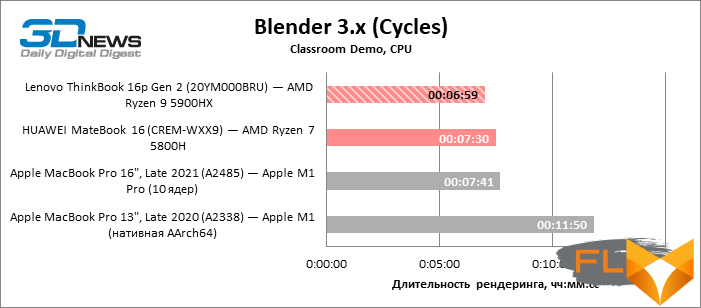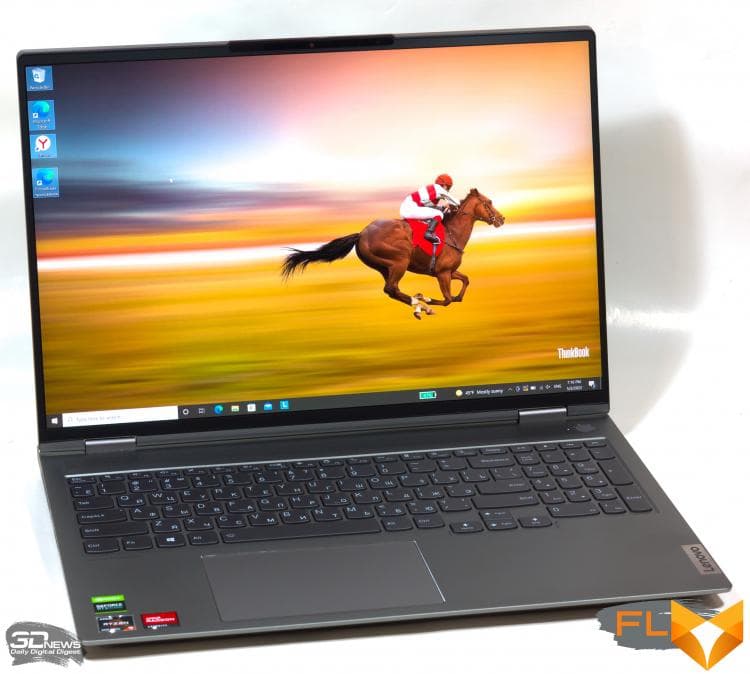


Lenovo’s ThinkBook series of notebooks is primarily associated with versatile machines without pretensions to high performance and feature richness. However, the new ThinkBook 16p Gen 2 is aimed not only and not so much at office workers, but at digital content creators. This is evidenced by a powerful filling and a large, 16-inch screen. Recently, many manufacturers have begun using panels of this size instead of the usual 15.6 inches, and the ThinkBook 16p Gen 2 illustrates another positive shift: from a 16:9 aspect ratio to a more convenient and efficient 16:10 in terms of area.
However, these superficial features alone are not enough to guarantee the ThinkBook 16p Gen 2 an unqualified success. Let’s take a look at what Lenovo’s engineers have done so well and what remains to be worked on in the inevitable Gen 3.
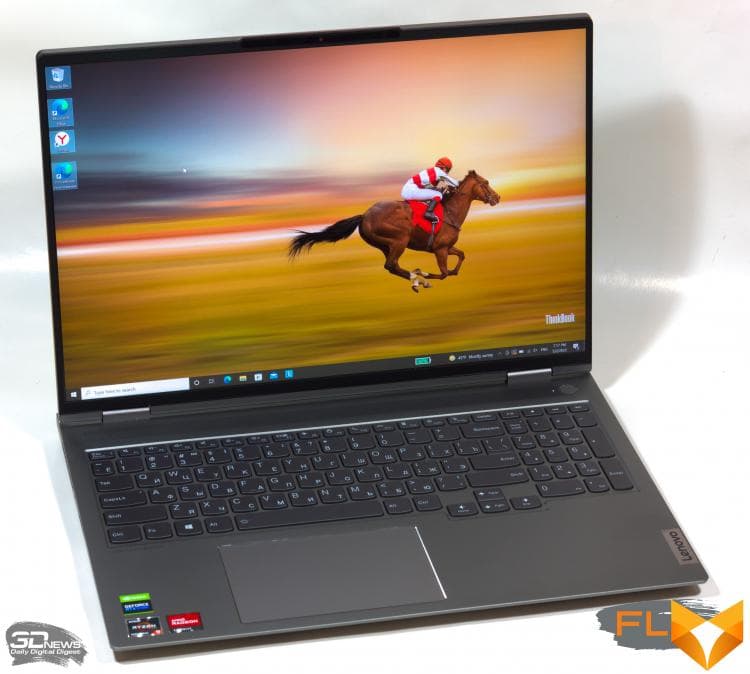
⇡#Specifications, prices
The ThinkBook 16p Gen 2 is available with either a six-core Ryzen 5 5600H CPU or one of the eight-core models, Ryzen 7 5800H or Ryzen 9 5900HX, which differ in x86 core and integrated GPU clock speeds. All of the processors listed are rated up to 54W, but tests will show that Lenovo has given the CPU an extra boost with a slight overclock.
In addition to a powerful central processor, the ThinkBook 16p Gen 2 received a discrete GeForce RTX 3060 video core with 6 GB of video memory. The power consumption of the RTX 3060 can vary widely, from 60W to 115W. But since the ThinkBook 16p Gen 2 is quite compact and thin, the TBP of the video adapter is fixed at 80W.
The rest of the ThinkBook 16p Gen 2 does not allow for a lot of variability in the composition of components. The amount of RAM, judging by the description of the machine on the manufacturer’s website and the configurations available at retail, is 16 or 32 GB, and the SSD is 512 GB or 1 TB.
While some laptops with a screen size of 15-16 inches boast the maximum battery capacity that airlines allow for carry-on baggage (99 Wh), Lenovo limited itself to a smaller 71 Wh battery.
| Manufacturer | Lenovo |
|---|---|
| Model | ThinkBook 16p Gen 2 |
| Display | 16”, 2560 × 1600, IPS |
| CPU | AMD Ryzen 9 5900HX (8/16 cores/threads, 3.3-4.6 GHz); AMD Ryzen 7 5800H (8/16 cores/threads, 3.2-4.4GHz); AMD Ryzen 5 5600H (6/12 cores/threads, 3.3-4.2 GHz) |
| RAM | DDR4 SDRAM, 3200 MT/s, up to 32 GB (2 channels) |
| GPU | NVIDIA GeForce RTX 3060 (6 GB) |
| Accumulator | WD PC SN730 (PCIe 3.0 x4), up to 1024 GB |
| External I/O connectors | 2 × USB 3.1 Gen 2 Type-C; 2 x USB 3.1 Gen 1 Type-A; 1 x SD; 1 x TRS 3.5mm |
| Network | IEEE 802.11ax; Bluetooth 5.0 |
| Battery capacity, Wh | 71 |
| Weight, kg | 1.99 |
| Overall dimensions (L × W × H), mm | 354.6 × 252 × 19.5 |
| USD retail price | 2700+ (AMD Ryzen 5 5600H, 16GB RAM, 512GB SSD) 4200+ (AMD Ryzen 9 5900HX, 32GB RAM, 1024GB SSD) |
Look and Ergonomics
The entire body of the ThinkBook 16p Gen 2, except for the screen bezel, is assembled from aluminum panels, and quite thick ones. This does not have the best effect on the mass of the device (about 2 kg), but it contributes to increased rigidity of the material under the keyboard and screen cover, although the display itself is not laminated here (and not sensitive to touch). The laptop is easy to open with one hand, and the lid tilts up to 180°.
The ThinkBook 16p Gen 2 uses the increasingly popular 16-inch screen, but the narrow bezels on the sides don’t make it look bigger than typical 15.6-inch devices. In addition, the screen has a 16:10 aspect ratio instead of the prevailing 16:9, so the horizontal indents from the edges of the lid are also smaller than usual. The screen cover is matte.
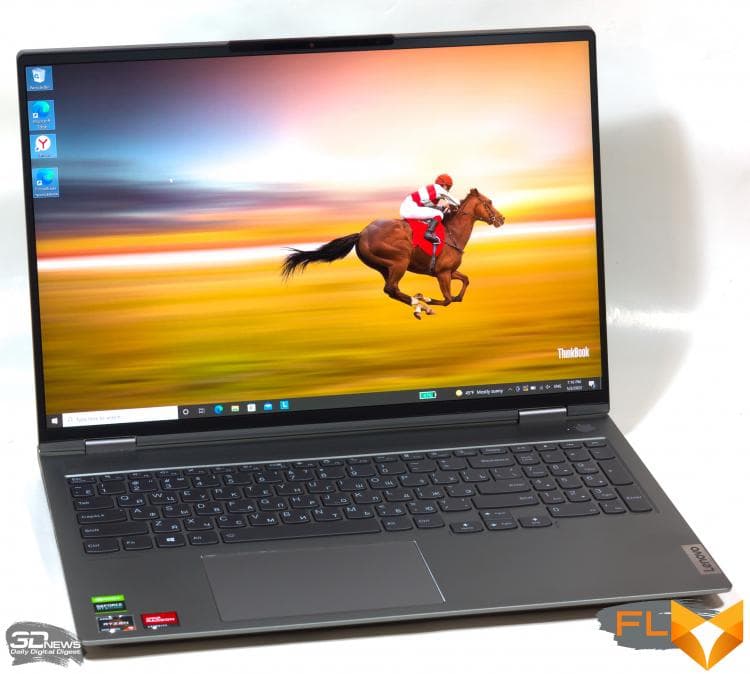
Laptop manufacturers have long learned to assemble screens in thin frames, but the task of placing a webcam still does not have an ideal solution. HUAWEI and HONOR hide it in the keyboard, Apple had to cut out a piece of the screen, and Lenovo placed the lens in a small ledge on the screen cover. The webcam has a sliding shutter and optional biometric user authentication.
A characteristic design feature of Lenovo gaming laptops, which is also borrowed from the ThinkBook 16p Gen 2, is that the axis of the screen hinges is shifted forward. Thus, part of the lower half of the case always remains in sight. On top there are LED indicators indicating the position of the three connectors – power and two USB Type-A ports. But the symbols light up only when the laptop is connected to a power outlet, so you still have to find the input for the power cable by touch.

The ThinkBook 16p Gen 2 has an excellent keyboard. It has a number pad, and the character keys, with the exception of the long-suffering “~”, have the same width. However, long-term users of business laptops will certainly complain about the lack of Del, Ins, PgUp and PgDn keys. In addition, for the sake of the digital block, all the keys had to be made rather small, and the hands, when typing blindly, are shifted to the left of the central axis of the body. Character backlighting is white, with two levels of brightness.
Most importantly, the ThinkBook 16p Gen 2’s key mechanics are better than most laptops we know of. Primarily due to the rigid chassis construction, but the mechanisms also provide a fairly long stroke of the covers and a clear actuation moment. It will be noted that the resistance of the cones under the keys is a little higher than necessary, and as a result the keys feel “viscous”, but, again, not many laptops can boast of the best controls.
The touchpad has a glass surface and provides flawless cursor tracking. The panel is well fixed in the body, does not emit any extraneous sounds, but it lacks rigidity, and this is well felt when pressure is applied to the corner.
The power button is separated from the main block of keys, and a fingerprint scanner is integrated into it – it’s good that Windows laptops began to use this solution after the Macs.
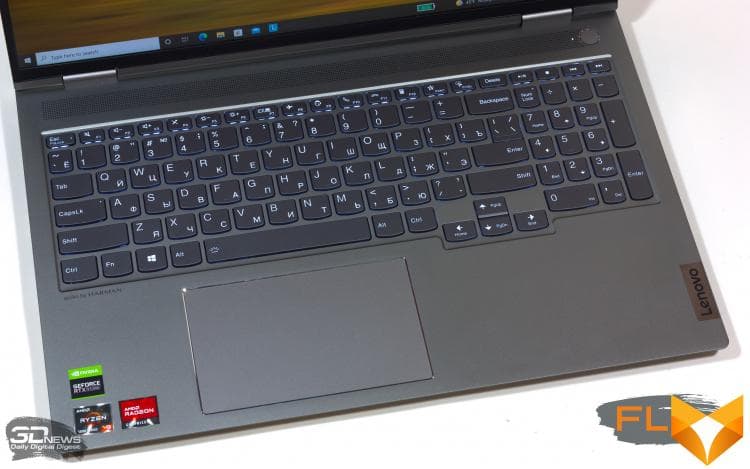
The sides of the ThinkBook 16p Gen 2 case taper closer to the front edge, which visually makes the device lighter, but the cooling grilles occupy the most “fleshy” part of the sides. As a result, there is very little space left on them for external connectors: a pair of USB Type-C on one side, a mini-jack and an SD card reader on the other – that’s all. Two more USB ports, already Type-A, along with a power connector are located on the back of the chassis. Still, the ThinkBook 16p Gen 2’s wired configuration is very spartan for a mobile workstation.

As for the decision to put some of the connectors on the back, it certainly gives the workplace a neat look, but if we were Lenovo engineers, we would swap one USB Type-A port with a Type-C port. Like it or not, the “outdated” connector is more often used to connect flash drives, hard drives, and the like, and Type-C is used for stationary peripherals, including external monitors, because the ThinkBook 16p Gen 2 does not have a separate HDMI or DisplayPort output.
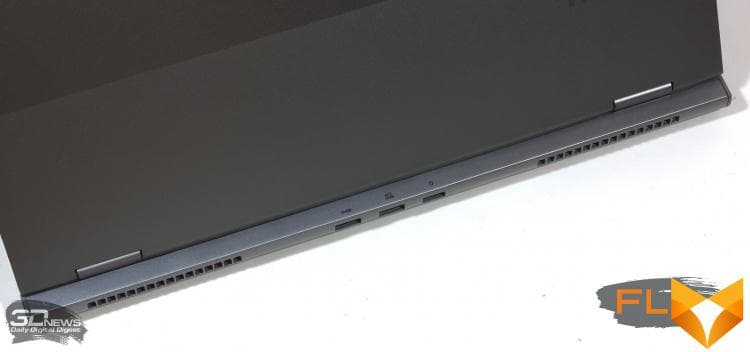
The laptop’s battery is charged by a hefty 230W power supply that will burden the traveling owner of the ThinkBook 16p Gen 2 with another kilo of luggage.
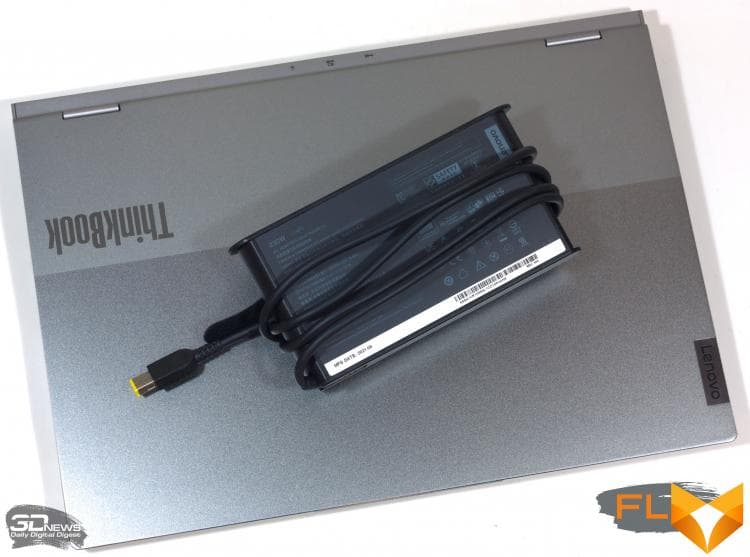
⇡#Internal design and upgrade options
The cooling system of the ThinkBook 16p Gen 2 works according to a scheme that is more typical for gaming laptops and workstations than for compact ultrabooks: cold air enters through the holes in the bottom panel, and hot air is not thrown up, but parallel to the table, through the grilles in the back of the case and On the sides.
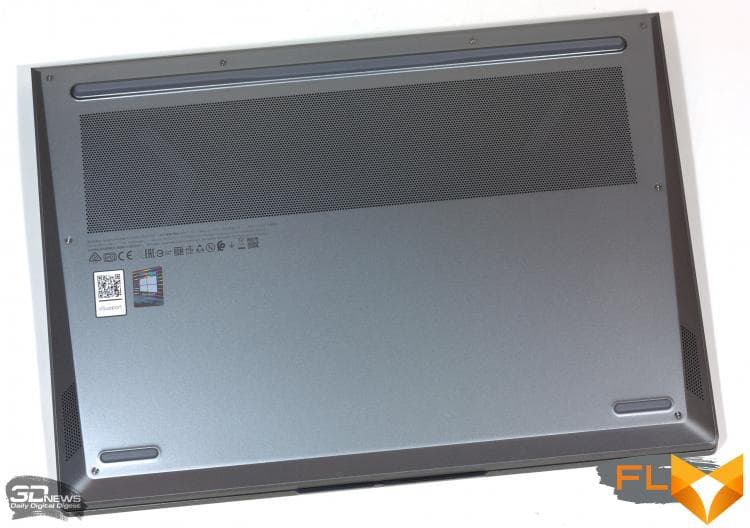
While Lenovo uses a vapor chamber to cool premium laptops, the ThinkBook 16p Gen 2 doesn’t have that luxury. Instead, it uses the usual design of a massive heat sink that covers the CPU, GPU and VRAM chips, and four heat pipes. A separate tube is laid in the area of the VRM power stages, but it does not have its own contact with the radiator, which would be very useful with such a high power consumption of the components.
Another feature in the ThinkBook 16p Gen 2 assembly is the external connectors: the largest of them (USB Type-A and power connector) are reinforced with metal frames.
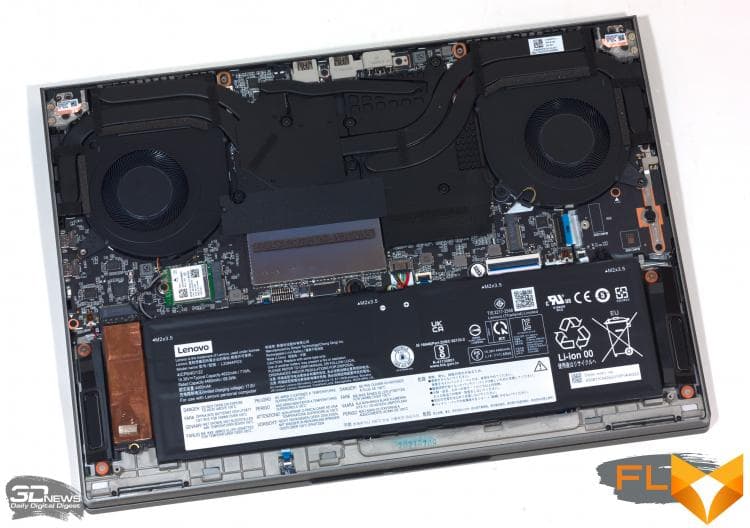
The Lenovo laptop allows you to upgrade the RAM and SSD by the user, but with certain restrictions. Of the 32 GB of RAM that is installed in the ThinkBook 16p Gen 2 test sample, 16 GB is already soldered on the motherboard, and another 16 is provided by the SO-DIMM module, covered with a metal cover. As a result, even by changing the pre-installed module to the maximum capacity DDR4 bar (32 GB), it is impossible to get a total amount of more than 48 GB. Fortunately, the need for 64 GB of RAM will arise only in heavy work tasks, which in any case require more powerful hardware than this laptop can offer. At the same time, laptop modifications with 16 GB of RAM carry only 8 GB on the motherboard, which means that the maximum amount after the upgrade is 40 GB.
To replace the ROM in the ThinkBook 16p Gen 2, you will have to transfer the copper foil wrapped around the “native” drive to the new SSD. It’s good that the motherboard has another, free M.2 slot, where you can install another SSD.
⇡#Test Methodology
| Synthetic tests | |
|---|---|
| Application | Settings |
| 3DMark Time Spy | — |
| Geekbench 5 | — |
| CINEBENCH R23 | — |
| GFXBench 5 (Aztec Ruins — Normal Tier, High Tier) | Windows: Vulkan, macOS: Metal |
| fio 3.16 | Sequential read/write, random read/write (unbuffered I/O) |
| Work Applications | |||||
|---|---|---|---|---|---|
| Application | Benchmark | Settings/Notes | API | ||
| Intel Graphics | AMD Graphics | NVIDIA Graphics | |||
| Adobe After Effects 2021 (18.x) | PugetBench for After Effects 0.93.2 (list of tests here) | — | OpenCL (Windows)/Metal (macOS) | OpenCL (Windows)/Metal (macOS) | CUDA |
| Adobe Photoshop 2021 (22.x) | PugetBench for Photoshop 0.93 (the composition of the tests at the link) | — | OpenGL + OpenCL + Metal (macOS) | OpenGL + OpenCL + Metal (macOS) | OpenGL + OpenCL |
| Adobe Photoshop Lightroom Classic 10.x | PugetBench for Lightroom Classic 0.92 (list of tests here) | — | DirectX 12 (Windows) | DirectX 12 (Windows) | DirectX 12 |
| Adobe Premiere Pro 2021 (15.x) | PugetBench for Premiere Pro V0.95.1 (list of tests at link) | Standard Benchmark (4K) | OpenCL (Windows)/Metal (macOS) | OpenCL (Windows)/Metal (macOS) | CUDA |
| Blackmagic Design DaVinci Resolve Studio 17.x | Puget Systems DaVinci Resolve Studio Benchmark V0.93 (test list at link) | Standard Benchmark (4K),
Use GPU for RED R3D (Debayer or Decompression and debayer): best option |
OpenCL | OpenCL | CUDA |
| Blender 2.9x | Class Room demo from Blender Foundation | Cycles renderer.
Feature Set: Supported. Tile size: 32 × 32 (CPU) or 256 × 256 (GPU) |
N/A (CPU rendering) | OpenCL (Windows)/CPU (macOS) | CUDA/OptX |
| AMD Nissan GTR Demo | Radeon ProRender for Blender 3.2.x | N/A | OpenCL (Windows)/Metal (macOS) | OpenCL | |
Display testing is performed using the X-Rite i1Display Pro Plus colorimeter in the DisplayCAL 3 application.
Notebook battery life is measured at a display brightness of 200 cd/m2in the following usage scenarios:
- web surfing: alternately opening and closing tabs of Computeruniverse.ru and Unsplash.com sites with an interval of 25 seconds in the Google Chrome browser (cache and cookies are disabled);
- Continuous playback of 4K HEVC (H.265) video.
⇡#Test participants
The following devices took part in testing:
| Screen | CPU | RAM | GPU | SSD | HDD | Battery | |||
|---|---|---|---|---|---|---|---|---|---|
| Lenovo ThinkBook 16p Gen 2 (20YM000BRU) | 16″, 2560 × 1600, IPS | AMD Ryzen 9 5900HX | 8/16 cores/threads, 3.3-4.6 GHz | DDR4 SDRAM, 3200 MT/s, 32 GB | NVIDIA GeForce RTX 3060 | 6GB GDDR6 | WD PC SN730 (PCIe 3.0 x4) 1024 GB | None | 71 Wh |
| Apple MacBook Pro 13″, Late 2020 (A2338) | 13.3”, 2560 × 1600, IPS | Apple M1 | 4+4 cores/threads, ≤3.2GHz | LPDDR4X SDRAM, 4266 MT/s, 16 GB | Apple G13G (8 cores) | System RAM | Apple AP2048Q (Apple Fabric) 2048 GB | None | 58.2 Wh |
| Apple MacBook Pro 16″, Late 2021 (A2485) | 16.2”, 3456 × 2234, IPS Mini LED | Apple M1 Pro (10 cores) | 8+2 cores/threads, ≤3.2/2.1GHz | LPDDR5 SDRAM, 6400 MT/s, 16 GB | Apple G13X (16 cores) | System RAM | Apple AP1024R (Apple Fabric) 1024 GB | None | 99.6 Wh |
| ASUS ExpertBook B7 Flip (B7402FE) | 14”, 1920 × 1200, IPS | Intel Core i7-1195G7 | 4/8 cores/threads, 2.9-4.6GHz | DDR4 SDRAM, 3200 MT/s, 64 GB | Intel Iris Xe Graphics G7 | 1 GB from system memory | Samsung PM9A1 (PCIe 4.0 x4) 1024 GB | None | 63 Wh |
| ASUS ROG Flow X13 (GV301QH-K5228T) | 13.4”, 3840 × 2400, IPS | AMD Ryzen 9 5980HS | 8/16 cores/threads, 3.1-4.8GHz | LPDDR4X SDRAM, 4266 MT/s, 32 GB | NVIDIA GeForce GTX 1650 Max-Q | 4GB GDDR6 | WD PC SN530 (PCIe 3.0 x4) 1024 GB | None | 62 Wh |
| GIGABYTE AERO 15 OLED (XD-73RU644SP) | 15.6”, 3840 × 2160, AMOLED | Intel Core i7-11800H | 8/16 cores/threads, 2.3-4.6GHz | DDR4 SDRAM, 3200 MT/s, 32 GB | NVIDIA GeForce RTX 3070 | 8GB GDDR6 | Phison ESR01TBTLG-E6GBTNB4 (PCIe 4.0 x4) 1024 GB | None | 99 Wh |
| HP ZBook Studio G7 (1J3W1EA) | 15,6”, 1920 × 1080, IPS | Intel Core i7-10850H | 6/12 cores/threads, 2.7-5.1 GHz | DDR4 SDRAM, 2933 MT/s, 16 GB | NVIDIA Quadro RTX 3000 Max-Q | 6GB GDDR6 | Samsung PM981a (PCIe 3.0 x4) 512 GB | None | 83 Wh |
| HUAWEI MateBook 16 (CREM-WXX9) | 16”, 2520 × 1680, IPS | AMD Ryzen 7 5800H | 8/16 cores/threads, 3.2-4.4GHz | DDR4 SDRAM, 3200 MT/s, 16 GB | AMD Radeon RX Vega 8 | 512MB of system RAM | WD PC SN730 (PCIe 3.0 x4) 512GB | None | 84 Wh |
⇡#Screen Quality
The ThinkBook 16p Gen 2 uses a relatively small screen matrix for a 16-inch diagonal, but an acceptable resolution of 2560 × 1600 pixels. It has a good margin of brightness – 387 cd/m2 – and a high contrast ratio of 1681:1.

By running the pre-installed X-Rite Color Checker utility, the user can prescribe a screen color profile in the operating system, which, judging by the results of further tests, is formed individually for each instance of the ThinkBook 16p Gen 2.
The range of shades of the panel almost completely covers the sRGB standard. We are not talking about extended P3 or Adobe RGB coverage, which, however, is more of an advantage than a disadvantage for most Windows users.
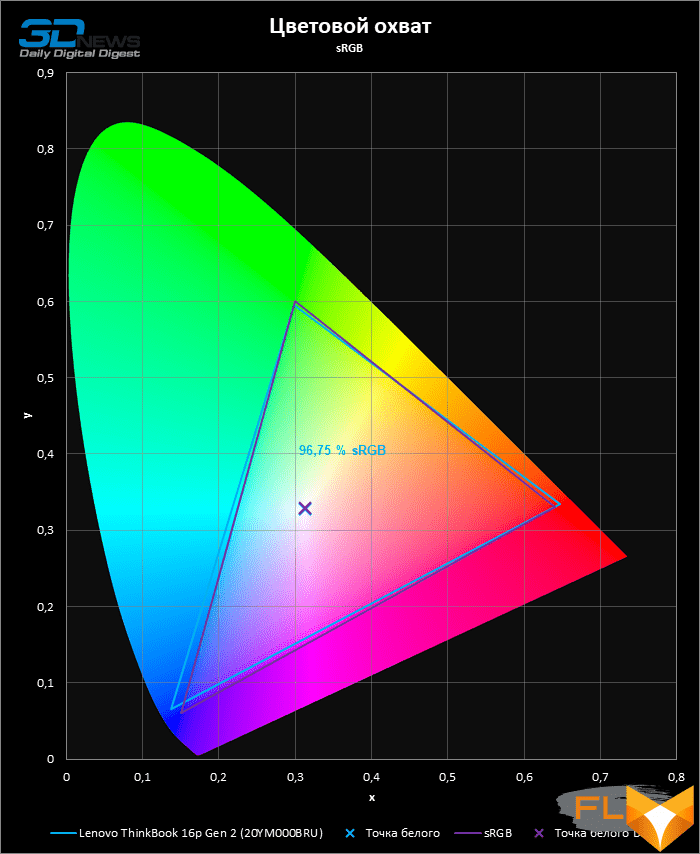
The color temperature of the screen exactly corresponds to the reference value of 6500 K throughout the entire gray scale.
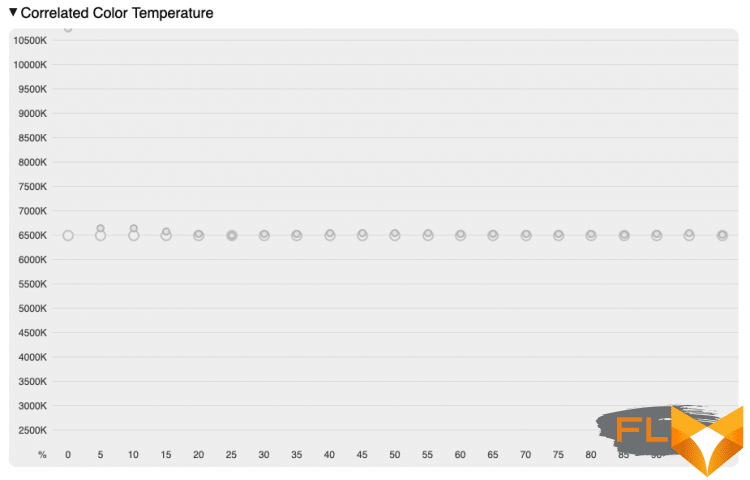
The gamma setting almost perfectly follows the complex curve of the sRGB standard. The gray balance also does not cause the slightest complaint, except for a short segment near the minimum brightness.
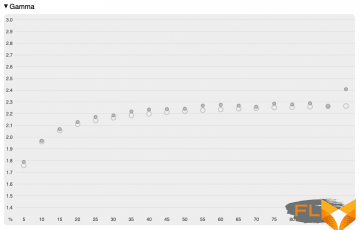 |
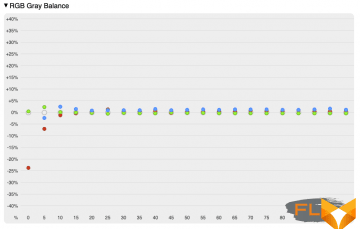 |
Due to precise profiling, the ThinkBook 16p Gen 2 screen exhibits high levels of color fidelity, making it suitable for professional color work without additional user calibration. The only pity is that most Windows applications outside the professional sphere, including the interface of the operating system itself, cannot work with screen profiles. That is, in them it is impossible to achieve the same exact color reproduction.
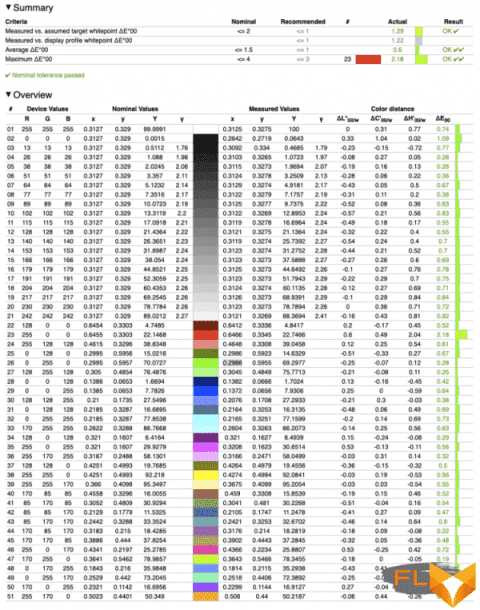
⇡#Clock speeds, temperature and noise levels
The top-of-the-line ThinkBook 16p Gen 2 features one of the highest-performing CPUs from the past generation, the AMD Ryzen 9 5900HX, which is rated at 54W. In fact, the ThinkBook’s voltage regulator delivers up to 60W to the chip when all cores are continuously loaded. As a result, the processor supports clock speeds that are extremely high by the standards of eight-core laptops – about 3.8 GHz. In turn, the GeForce RTX 3060 discrete video adapter on the GA106 core develops a power of 79 out of a possible 115 W and a clock speed of 1.5 GHz. With simultaneous loading of the CPU and GPU, the laptop automation, as usual, prefers discrete graphics, and yet the CPU performance remains at a high level: the stable frequency of the video core drops to 1.4 GHz, and the x86 cores to 3.2 GHz.
The ThinkBook 16p Gen 2 achieved these results in the maximum performance mode set by the Lenovo Vantage laptop management software. At maximum load, the components reach typical high temperatures for such devices (CPU warms up to 100 ° C, and GPU – up to 84), but the cooling system is not at all as loud as you might think. The sound pressure of 44 dBA at 30 cm from the screen is still not comfortable, but powerful work laptops are full of noisier machines.
| Load Clock | ||||||||
|---|---|---|---|---|---|---|---|---|
| Cinebench R20 (Max Thread #) | Blender 2.9x (GPU rendering) | Cinebench R20 (max thread no.) + Blender 2.9x | ||||||
| CPU clock speed, MHz | GPU clock speed, MHz | CPU clock speed, MHz | GPU clock speed, MHz | |||||
| Medium | Max | Medium | Max | Medium | Max | Medium | Max | |
| Lenovo ThinkBook 16p Gen 2 (20YM000BRU) — AMD Ryzen 9 5900HX / NVIDIA GeForce RTX 3060 — Extreme Performance Mode | 3839 | 3918 | 1541 | 1657 | 3264 | 3391 | 1442 | 1717 |
| Lenovo ThinkBook 16p Gen 2 (20YM000BRU) — AMD Ryzen 9 5900HX / NVIDIA GeForce RTX 3060 — Intelligent Cooling Mode | 3563 | 3643 | 1301 | 1395 | 3278 | 4168 | 1274 | 1492 |
| Lenovo ThinkBook 16p Gen 2 (20YM000BRU) — AMD Ryzen 9 5900HX / NVIDIA GeForce RTX 3060 — Battery Saving Mode | 2202 | 2302 | 1211 | 1282 | 2209 | 3459 | 1221 | 1282 |
| Power consumption of CPU and GPU | ||||||||
|---|---|---|---|---|---|---|---|---|
| Cinebench R20 (Max Thread #) | Blender 2.9x (GPU rendering) | Cinebench R20 (max thread no.) + Blender 2.9x | ||||||
| CPU power consumption, W | GPU power consumption, W | CPU power consumption, W | GPU power consumption, W | |||||
| Medium | Max | Medium | Max | Medium | Max | Medium | Max | |
| Lenovo ThinkBook 16p Gen 2 (20YM000BRU) – AMD Ryzen 9 5900HX / NVIDIA GeForce RTX 3060 – Extreme Performance Mode | 60 | 62 | 79 | 79 | 35 | 35 | 76 | 76 |
| Lenovo ThinkBook 16p Gen 2 (20YM000BRU) – AMD Ryzen 9 5900HX / NVIDIA GeForce RTX 3060 – Intelligent Cooling Mode | 45 | 48 | 62 | 62 | 35 | 35 | 62 | 62 |
| Lenovo ThinkBook 16p Gen 2 (20YM000BRU) – AMD Ryzen 9 5900HX / NVIDIA GeForce RTX 3060 – Battery Saving Mode | 15 | 15 | 34 | 34 | 15 | 15 | 34 | 34 |
Note The measurement is performed after the device has warmed up and all parameters have stabilized.
Switching to “intelligent” cooling mode significantly reduces the noise and heat of the ThinkBook 16p Gen 2 components at the cost of reducing the power reserve of the CPU and GPU to 45 and 62 watts, respectively. The clock frequencies of the microcircuits under separate load fluctuate around 3.6 and 1.3 GHz, and the combined load strangles the GPU more than in the maximum performance mode.
Finally, in power-saving mode, the ThinkBook 16p Gen 2 is extremely quiet compared to a typical office or residential environment. Economy mode turns the ThinkBook 16p Gen 2 into the equivalent of a regular ultrabook, both in terms of power consumption and component clock speeds. The Ryzen 9 5900HX chip does not consume more than 15W of power, and the frequency of the x86 cores in the benchmark has stabilized at 2.2 GHz. The discrete video adapter supports 1.2 GHz, and exactly the same parameters are observed in the combined stress test.
Note that even at minimal load without any demanding applications, the laptop cooler does not become completely silent – hence the low CPU temperature in idle and a cool work surface.

Note Idle and sustained CPU (SoC) temperatures for all CPU cores
Note GPU Idle Temperature (SoC) and Long GPU Load
Note Temperature of the CPU and GPU during prolonged simultaneous load on both chips.
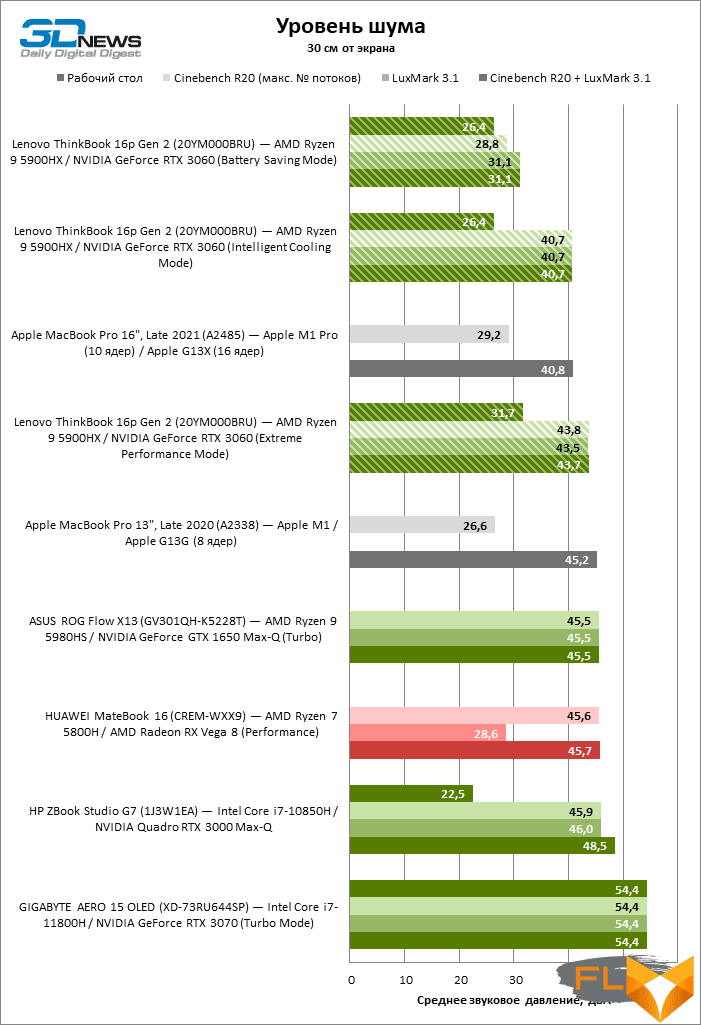
⇡#Synthetic performance tests
The Ryzen 9 5900HX octa-core CPU has tremendous performance potential, especially with increased power headroom. Although in single-threaded performance metrics, even high clock speeds do not allow AMD chips to compete on equal terms with Intel or Apple offerings, but with a long load on all cores, the ThinkBook 16p Gen 2 took first place among all work laptops we know. Calculations of a short, explosive nature return Intel processors and the Apple M1 Pro chip to the first places.
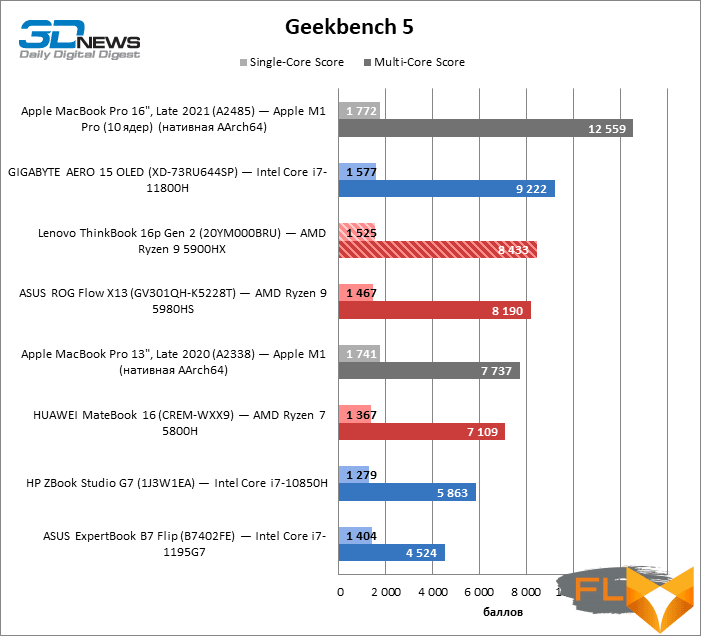
The GeForce RTX 3060 video adapter falls into the “above average” category by the standards of discrete laptop graphics. As a result, it drastically outperforms integrated solutions from Intel or AMD in 3D rendering tests and won a slight advantage over the 16 cores of Apple M1 Pro integrated graphics. The next level of performance is opened by the more powerful and expensive GeForce RTX 3070.
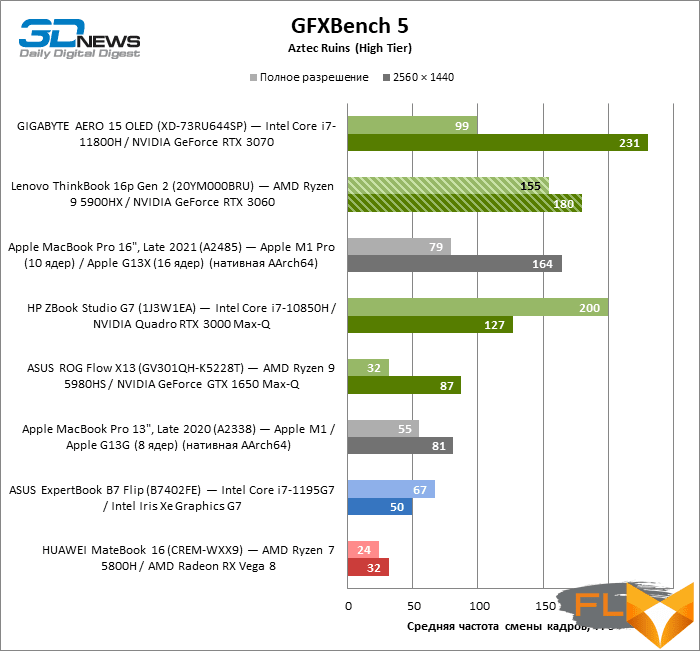
⇡#Performance in production applications
The ThinkBook 16p Gen 2 took the lead among Windows laptops in the Blender benchmark for CPU-assisted scene rendering, and was only marginally behind the M1 Pro-based MacBook Pro.
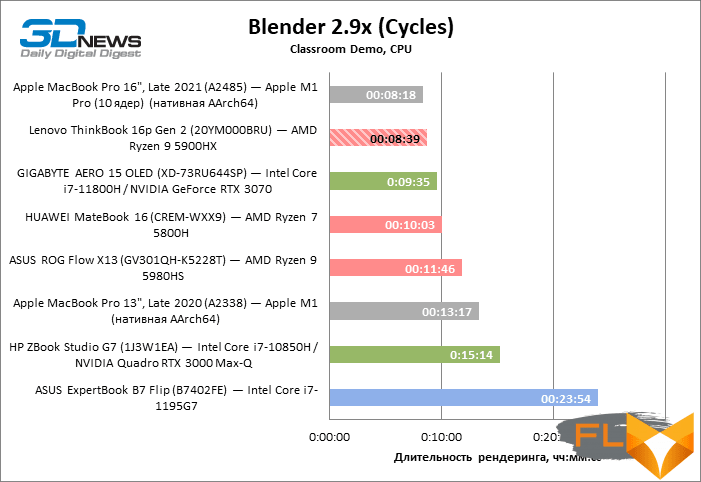
Unlike laptops without discrete graphics, the ThinkBook 16p Gen 2 allows you to speed up rendering several times by shifting the load to a separate GPU. The RT blocks available through the OptiX API are especially useful in this matter (in such conditions, the GeForce RTX 3060 even comes close to the RTX 3070).

We’ve only recently begun building a database of benchmark results for the new version of Blender, so the ThinkBook 16p Gen 2 has a limited set of competitors. Nevertheless, we can already say that in Blender 3.x, the slightly overclocked Ryzen 9 5900HX is not much, but still ahead of the Apple M1 Pro in rendering speed, and the GeForce RTX 3060 is many times superior to the integrated graphics of the same system-on-a-chip.

As you know, Adobe applications run best on the Intel platform, however, thanks to the high power of the CPU and fast discrete graphics, the ThinkBook 16p Gen 2 broke into second place in the Lightroom benchmark results chart, losing the lead only to the “blue” laptop with the GeForce RTX 3070 video adapter.
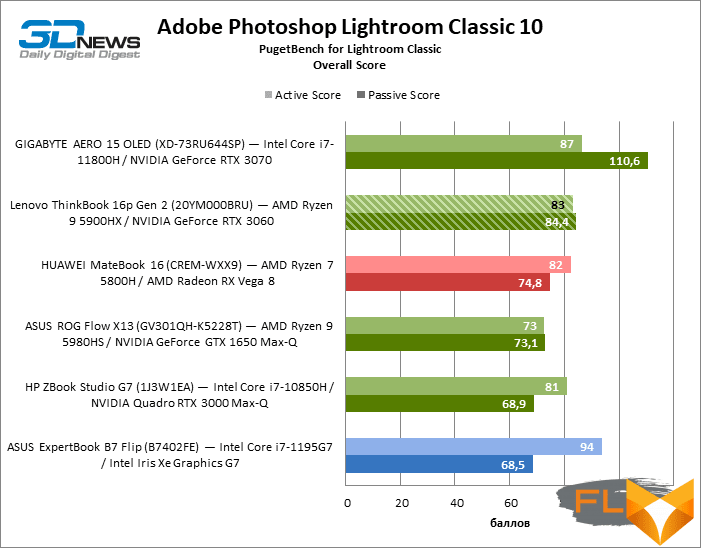
Note Scores are calculated as a percentage of the performance of a reference workstation with Intel Core i9-9900K, NVIDIA GeForce RTX 2080 and 64GB RAM.
Exactly the same result is shown by tests in Photoshop.

Note Scores are calculated as a percentage of the performance of a reference workstation with Intel Core i9-9900K, NVIDIA GeForce RTX 2080 and 64 GB of RAM times 10.
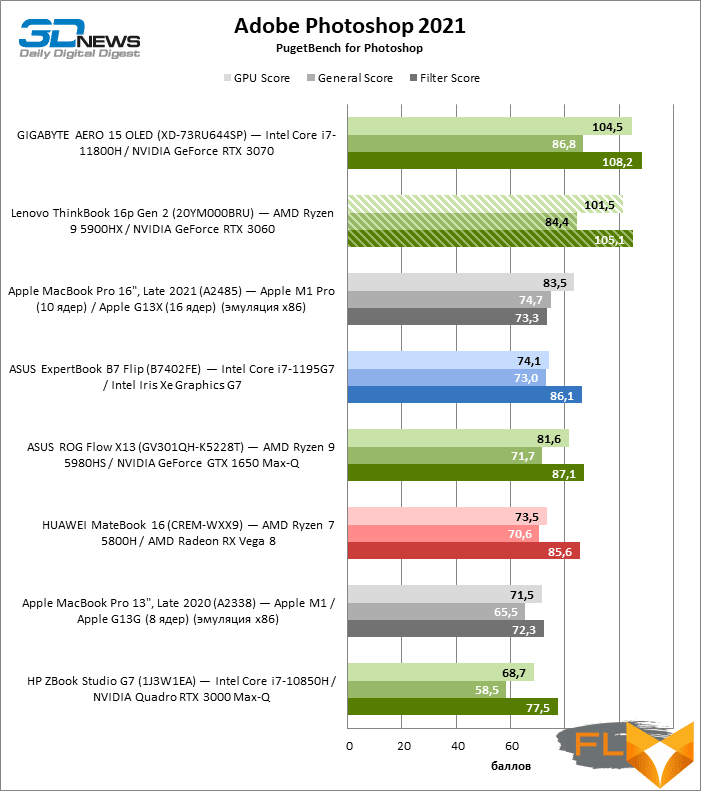
Note Scores are calculated as a percentage of the performance of a reference workstation with Intel Core i9-9900K, NVIDIA GeForce RTX 2080 and 64GB RAM.
In Premiere Pro, the GPU plays a leading role, so it is quite predictable that the ThinkBook 16p Gen 2 scored ahead of the other Windows devices that we brought in for comparison, with the exception of the notorious laptop with a GeForce RTX 3070 on board.
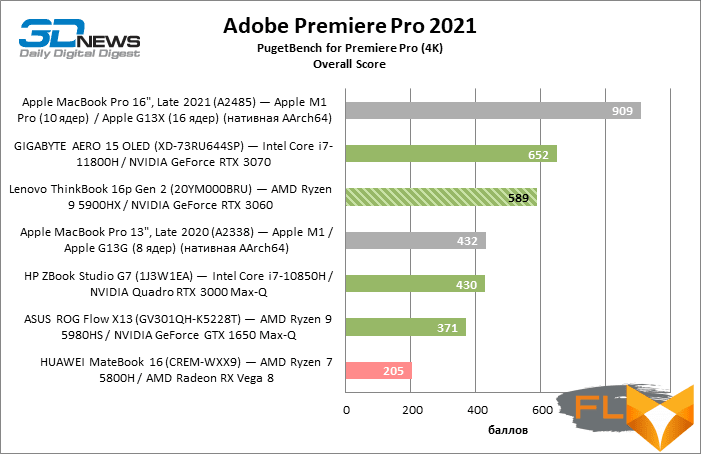
Note Scores are calculated as a percentage of AMD Ryzen 9 5900X, NVIDIA GeForce RTX reference workstation performance 3080 and 64 GB of RAM times 10.
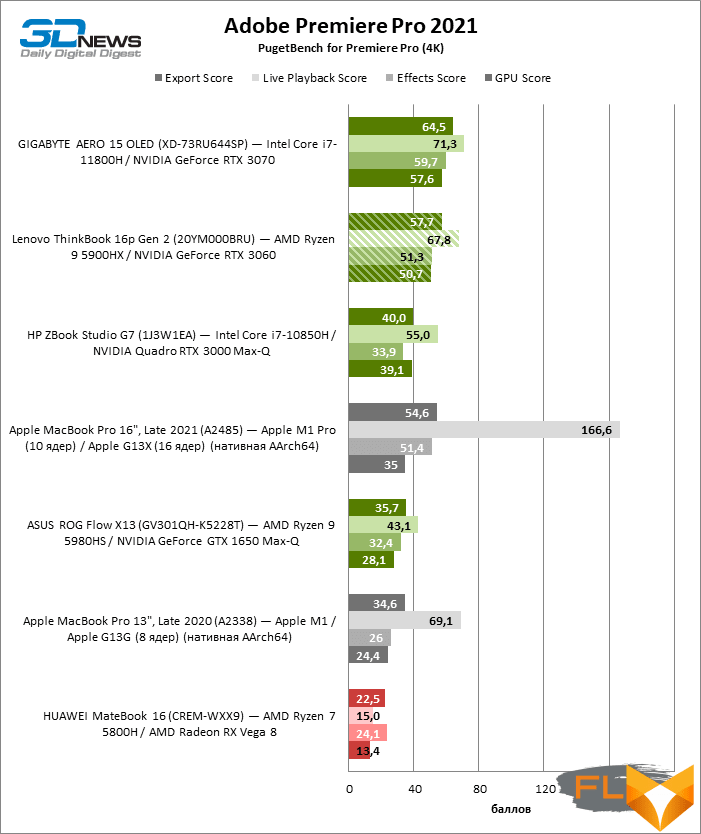
Note Scores are based on a percentage of the performance of a reference workstation with AMD Ryzen 9 5900X, NVIDIA GeForce RTX 3080 and 64GB RAM.
The combination of an octa-core CPU and high-performance discrete graphics is at its best when it comes to video encoding and exporting. On the other hand, smooth playback of the project in native 4K at 60 FPS is provided by any workstation tested in this review, as long as its GPU is slightly more powerful than the GeForce GTX 1650 Max-Q. But the same task, but already in the multi-camera mode, was only up to the “Macbook” on the M1 Pro chip.
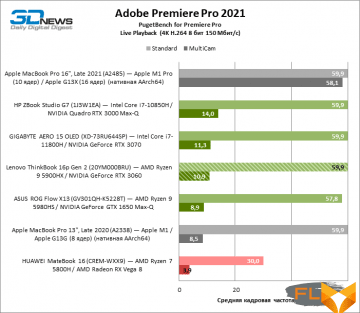 |
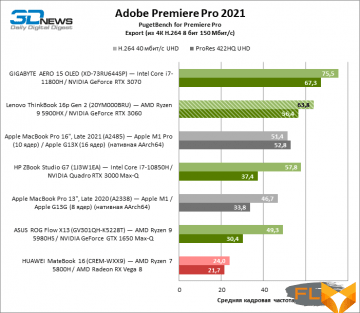 |
Adobe After Effects, by and large, has the same hardware requirements as Premiere Pro. The excellent CPU of the ThinkBook 16p Gen 2 gave Lenovo the second place on the podium, but the gold medal went to a machine equipped with a more powerful GeForce RTX 3070 graphics card.
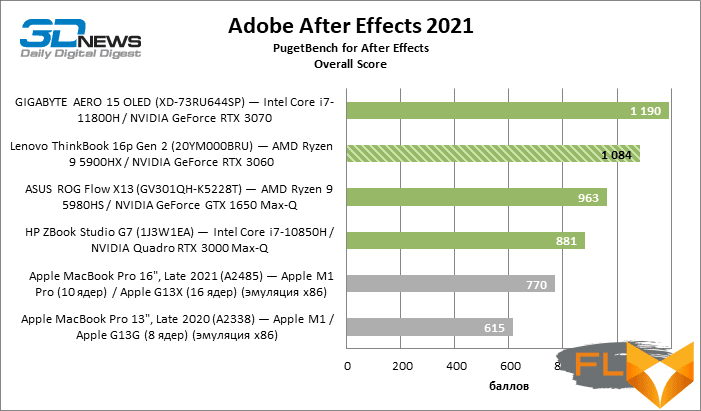
Note Scores are calculated as a percentage of the performance of a reference workstation with Intel Core i9-9900K, NVIDIA GeForce RTX 2080 and 64 GB of RAM times 10.

Note Scores are calculated as a percentage of the performance of a reference workstation with Intel Core i9-9900K, NVIDIA GeForce RTX 2080 and 64GB RAM.
Finally, according to the DaVinci Resolve test points, the Lenovo mobile workstation once again found itself in the gap between laptops based on the 11th generation Intel CPU and GeForce RTX 3060 on the one hand and the 10th generation Core along with Quadro RTX 3000 Max-Q graphics on the other. This configuration is observed in tests that depend on the speed of the GPU, and in tests of Fusion, which are the most CPU-intensive.

Note Scores are calculated as a percentage of the performance of a reference workstation with Intel Core i9-10900K and NVIDIA TITAN RTX multiplied by 10.
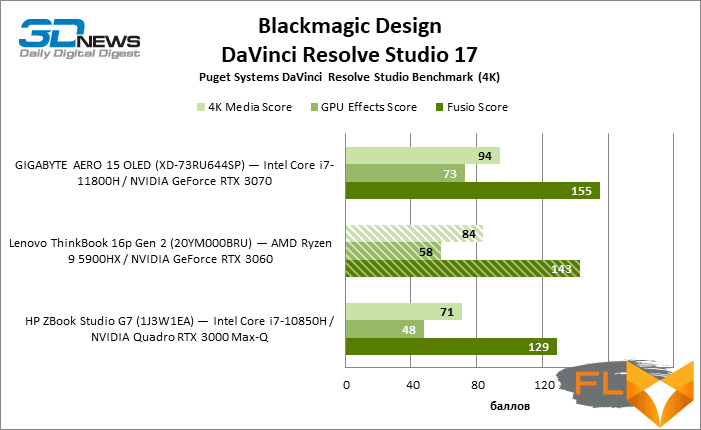
Note Scores are calculated as a percentage of the performance of a reference workstation with Intel Core i9-10900K and NVIDIA TITAN RTX.
⇡#SSD performance
Our Lenovo ThinkBook 16p Gen 2 has a PC SN730 SSD from Western Digital. This solution for the mass market, which develops a fairly high speed of sequential and random reads by the standards of SSDs on the PCI Express 3.0 x4 bus, has good random write performance and mediocre linear write performance.
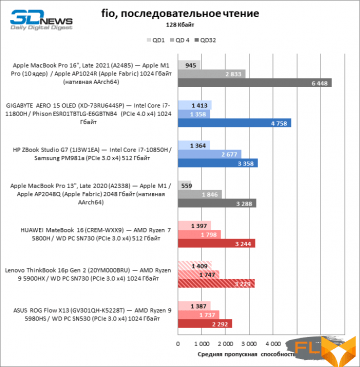 |
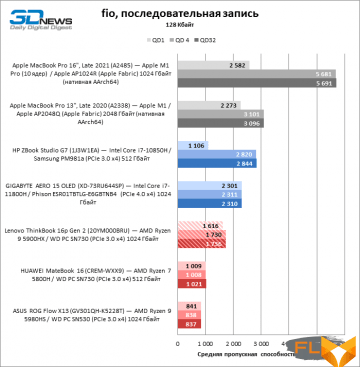 |
|
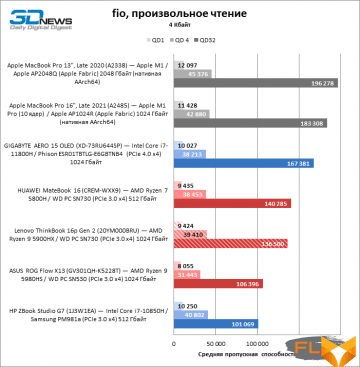 |
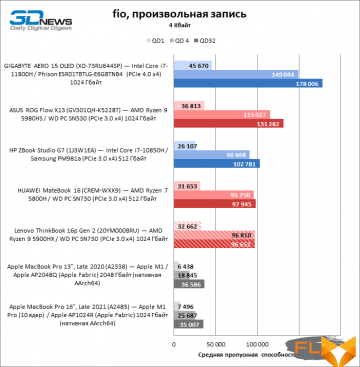 |
⇡#Battery Life
Compared to other expensive 15- and 16-inch laptops based on Intel and AMD processors, the ThinkBook 16p Gen 2 has a small battery capacity and, as a result, cannot boast the same long battery life: only 7 and a half hours of web surfing or 6 hours of video playback.
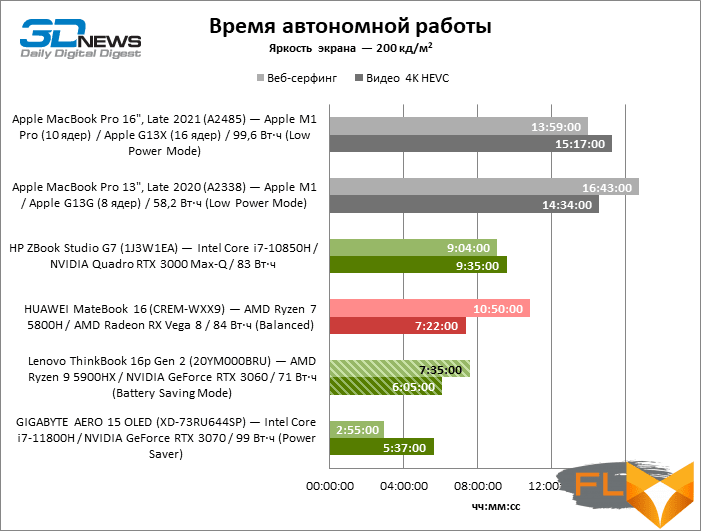
⇡#Conclusions
The Lenovo ThinkBook 16p Gen 2 can be described as a powerful all-round laptop or as an entry-level mobile workstation. The word “powerful” in this case refers to the Ryzen 5000 series CPU. These chips have proven themselves in gaming machines and thin ultrabooks, and now on the AMD platform there is a whole host of solutions aimed at enterprise users and, in this case, digital content creators. Category H Ryzen processors are ideal for this work due to high multi-threaded performance: Lenovo uses six- or eight-core chips with power consumption even above the official 54W ceiling and corresponding clock speeds. In turn, the GeForce RTX 3060 discrete graphics embodies a good balance between performance and appetite, because we are far from the largest and heaviest laptop among its fellows. We only advise potential owners of the ThinkBook 16p Gen 2 not to postpone the upgrade of RAM until later if work tasks require more than 16 GB of RAM, and immediately take the 32 GB configuration, because. half of the volume is soldered on the motherboard, and there is only one SO-DIMM slot. But there is a rare opportunity to install an additional SSD.
In order to make the device thinner and lighter, Lenovo engineers had to sacrifice something: this model has a relatively small battery capacity and, as a result, you can’t count on being free from the mains for the whole day. However, for such laptops, autonomy is not as important as a hard case and a massive, and therefore efficient cooling system. Indeed, for all the power of the main components, even at maximum performance, the ThinkBook 16p Gen 2 is not at all as noisy as many similar computers. The list of advantages of the ThinkBook 16p Gen 2 continues with a high-quality keyboard (with a numeric keypad), a touchpad, and, most importantly, a screen. The resolution of 2560 × 1600 pixels no longer seems high at 16 inches, but it is a high-contrast screen with a comfortable 16:10 aspect ratio and an accurate profile that allows you to start working with color without recalibration. The only thing missing is additional ports for connecting peripherals – we hope Lenovo will pay attention to this in the next iteration of the flagship ThinkBook.

